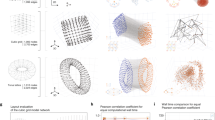Abstract
Achieving effective network graphic design is not that different from any other type of information graphic. As Edward Tufte pointed out in his seminal The Visual Display of Quantitative Information, “Graphical excellence is that which gives to the viewer the greatest number of ideas in the shortest time with the least ink in the smallest space.” Network graphics actually start out with an important advantage in that they typically have a high information/ink ratio.
As with any graphic, networks are used in order to discover pertinent groups or to inform others of the groups and structures discovered. It is a good means of displaying structures. However, it ceases to be a means of discovery when the elements are numerous. The figure rapidly becomes complex, illegible and untransformable. (Jacques Bertin)
Access this chapter
Tax calculation will be finalised at checkout
Purchases are for personal use only
Similar content being viewed by others
References
Murrell P (2005) R graphics. Taylor & Francis, p 328. ISBN:158488486X. https://books.google.com/books?id=fUUVngEACAAJ&pgis=1
Author information
Authors and Affiliations
Rights and permissions
Copyright information
© 2015 Springer International Publishing Switzerland
About this chapter
Cite this chapter
Luke, D.A. (2015). Effective Network Graphic Design. In: A User’s Guide to Network Analysis in R. Use R!. Springer, Cham. https://doi.org/10.1007/978-3-319-23883-8_5
Download citation
DOI: https://doi.org/10.1007/978-3-319-23883-8_5
Publisher Name: Springer, Cham
Print ISBN: 978-3-319-23882-1
Online ISBN: 978-3-319-23883-8
eBook Packages: Mathematics and StatisticsMathematics and Statistics (R0)




